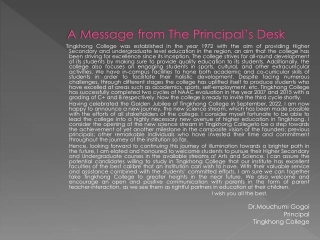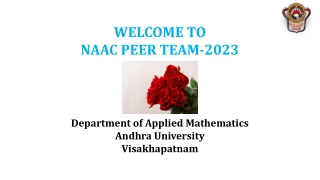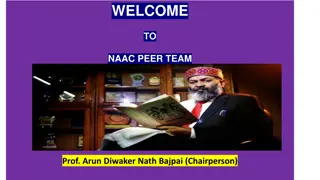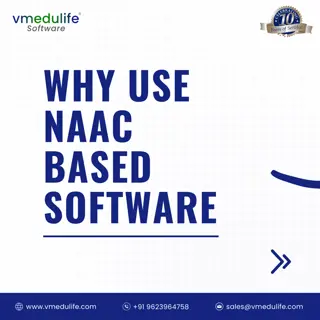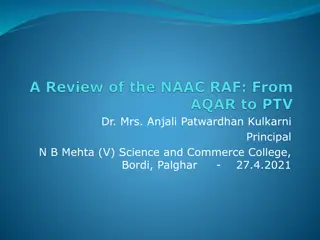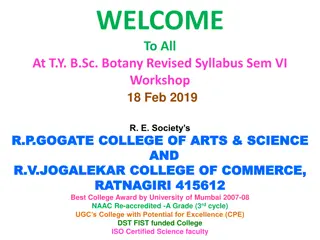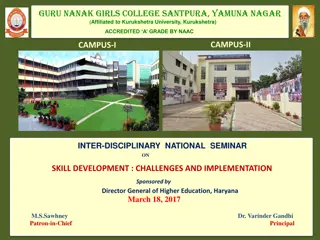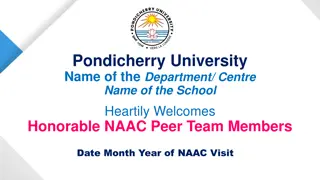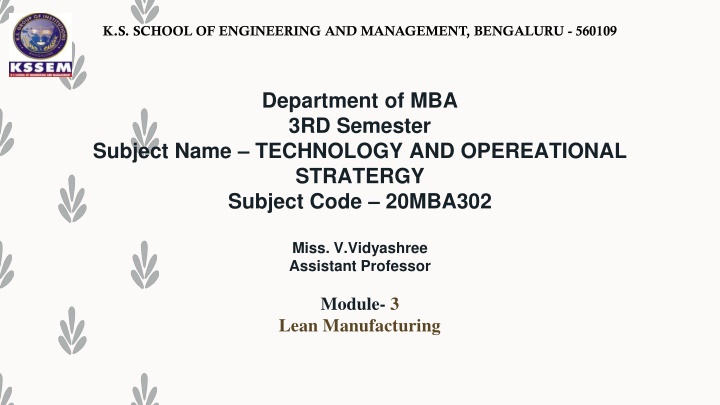
Lean Manufacturing: Principles and Benefits for Organizational Efficiency
Explore the concept of Lean Manufacturing, its history, 5 principles, and benefits for organizations. Lean Management focuses on improving work processes and productivity through strategies like the Toyota Way and Just-In-Time operations. Learn how Lean Management enhances efficiency, resource utilization, and workforce focus.
Download Presentation

Please find below an Image/Link to download the presentation.
The content on the website is provided AS IS for your information and personal use only. It may not be sold, licensed, or shared on other websites without obtaining consent from the author. If you encounter any issues during the download, it is possible that the publisher has removed the file from their server.
You are allowed to download the files provided on this website for personal or commercial use, subject to the condition that they are used lawfully. All files are the property of their respective owners.
The content on the website is provided AS IS for your information and personal use only. It may not be sold, licensed, or shared on other websites without obtaining consent from the author.
E N D
Presentation Transcript
K.S. SCHOOL OF ENGINEERING AND MANAGEMENT, BENGALURU - 560109 Department of MBA 3RD Semester Subject Name TECHNOLOGY AND OPEREATIONAL STRATERGY Subject Code 20MBA302 Miss. V.Vidyashree Assistant Professor Module- 3 Lean Manufacturing
Conceptof Lean Manufacturing; meaning of lean manufacturing; History of Lean Operations, Typesof Waste, Module -3 Lean Manufacturing 5S Techniqueof Eliminating the Waste, Lean Operationsin the service sector, Role of Leadership, Lean Operations JustIn Time(JIT).
Concept of Lean Manufacturing Lean management is based on the Toyota production system which was established in the late 1940s. Toyota put into practice the five principles of lean management with the goal being to decrease the amountof processesthat were not producing value; this became known as the Toyota Way. By implementing the five principles, they found that significant improvements were made in efficiency, productivity, costefficiency andcycle time.
5 principles of lean management Lean management incorporates five guiding principles that are used by managerswithin an organizationas the guidelines to the lean methodology.The five principles are: Identifyvalue Valuestream mapping Createa continuousworkflow Establisha pullsystem Facilitatecontinuousimprovement
Benefits of lean management Lean management benefits organizations by focusing on improving all parts of the work process throughout every level of the company's hierarchy. Specifically, managers benefit from advantages such as: Amore intelligent business process -The pull system ensures work is only carried out when there is an actual demand and need for it. Improved use of resources - The pull system also ensures the organization is only using resources when they are needed since it operates based on real customer demand. Improved focus - Lean management decreases the amount of wasteful activities, therefore allowing the workforce to increase their focus on tasks that produce value. Enhanced productivity and efficiency - Improved focus leads to a more productive and efficient workforce since attention is not given to unnecessary activities.
HISTORYOF LEAN MANUFACTURING https://www.youtube.com/watch ?v=ejhYJ6sMMSY
https://ww w.lean.org/ lexicon- terms/seve n-wastes/
7 Wastes of Lean Manufacturing Transportation in production, it may mean moving parts and materials from one place to another Inventory undelivered products or parts. Overstocking with equipment that may be in need somewhere in the future Motion unnecessary movement of employees or machinery Waiting waiting for goods to be delivered Overproduction too many items produced just in case Over-processing Spending a lot of time on a given task. Adding a feature that doesn t bring value Defects broken parts or defective parts that need to be reworked
7 Wastes in SoftwareDevelopment Transportation switchingbetween tasks too often,countless interruptions fromcolleagues. Inventory undelivered code or undelivered features Motion unnecessary meetings or extra effort to find information Waiting waitingfor testing to complete,waiting for codereview, and soon Overproduction producing features that nobody is goingto use Over-processing unnecessary complexalgorithmssolving simpleproblems Defects bugs
7 Wastes in Marketing Transportation task switching,interruptions,unnecessarylong marketing funnel Inventory fully-preparedmarketing campaignswhich stayunlaunched.Licensed toolsthat nobodyuses Motion unnecessarymeetings, extraefforttofind information,attendingevents without clear agenda Waiting waiting forapprovalfrom higher management Overproduction performing many differentmarketing activitieswithout havinga clear vision and strategy Over-processing generatingcountlessmarketing reportsmanually, while they canbe automated Defects wrongbrandcommunication,mistakenly brandedmaterials
5S A VIDEO ON THE CONCEPT https://www.creativesafetysupply.com/content/education- research/5S/index.html

